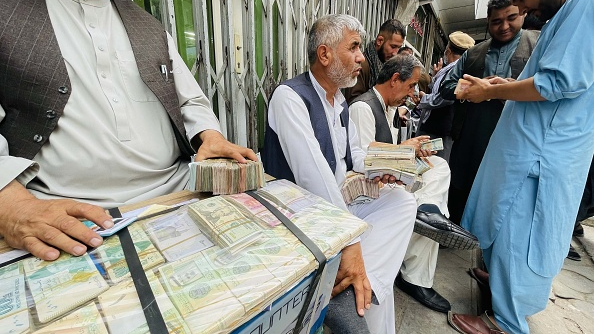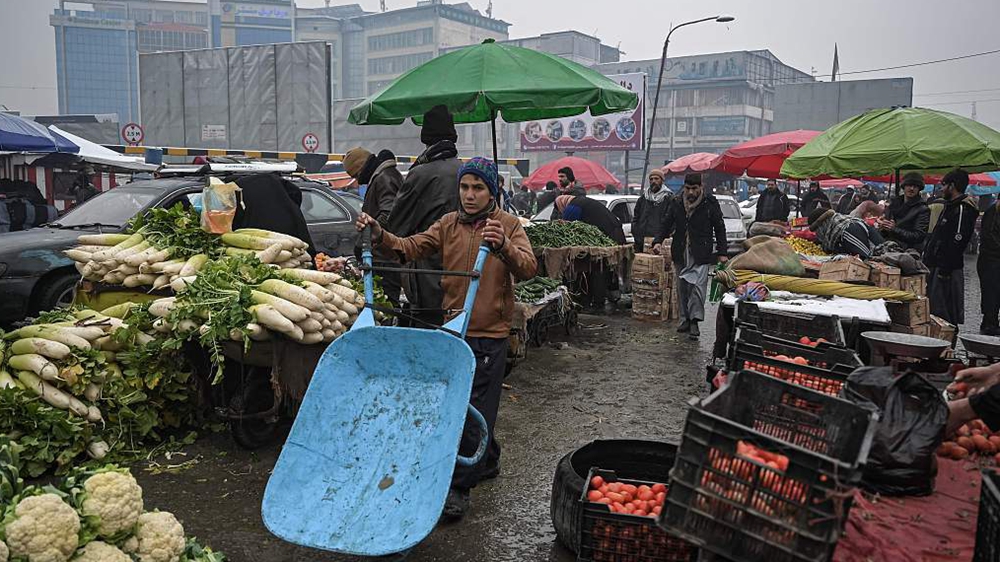
Afghan currency exchange dealers have been hit hard following the fall in value of the Afghani currency, leading to a rise in food prices in Kabul, Afghanistan, July 16, 2021. /Getty
Afghan currency exchange dealers have been hit hard following the fall in value of the Afghani currency, leading to a rise in food prices in Kabul, Afghanistan, July 16, 2021. /Getty
Editor's note: Hamzah Rifaat Hussain, a former visiting fellow at the Stimson Center in Washington and former assistant researcher at the Islamabad Policy Research Institute, is a TV anchor at Indus News in Pakistan. The article reflects the author's opinions and not necessarily those of CGTN.
While it is undoubtedly true that humanitarian agencies largely averted a looming food crisis as predicted by the World Food Program in its assessments in 2021 in Afghanistan, the battered national economy continues to struggle with the residual effects of war in 2022. The roots of Afghanistan's economic stagnation run deep and international assistance can only partly ameliorate exigencies such as widespread hunger and starvation.
A concerted attempt at resuscitating the foundations of the national economy based on political will from the Joe Biden administration has been lacking and if current trends persist, an irreversible decline becomes imminent in the post U.S. withdrawal era.
Addressing hunger is an immediate concern in Afghanistan, however assisting the population in the long run requires policies aimed at stimulating commercial activity, attracting foreign direct investment and investing in a flailing agricultural sector which is the backbone of the agrarian economy. Afghanistan however, continues to reel from the effects of donors cutting off financial aid which had otherwise constituted 70 percent of total governmental expenditures after the U.S. withdrawal.
Furthermore, growth-oriented policies remain shackled with United States either sidelining or ignoring warnings from the United Nations over impending starvation which required an immediate response.
The response however has been anything but immediate but lopsided and duplicitous instead. Note the splitting of $7 billion worth of frozen Afghan funds by the Biden administration in 2022 which angered and alienated the local population as they face cash shortages, joblessness and hunger in the post war scenario. Other issues also remain unresolved such as a massive liquidity crisis worsened by restrictions on the functionality of the Central Bank in Kabul. International payments have also been cut off which has meant that the Afghan economy has been shut out of the global financial system.

A boy pushes an empty wheelbarrow along a market on a cold day in Kabul, Afghanistan, January 19, 2022. /CFP
A boy pushes an empty wheelbarrow along a market on a cold day in Kabul, Afghanistan, January 19, 2022. /CFP
The inability of the Biden administration to spearhead and implement policies which deal with these realities has contributed to the country's predicament. As per U.N. Special Representative Deborah Lyons, six months of indecision, unstructured political engagement, erosion of vital social and economic coping systems and persistence with sanctions has contributed to this economic meltdown.
Perhaps the Biden administration and those championing Afghanistan's economic resilience after the U.S. withdrawal in 2021 should factor in how respective governments in Kabul have historically relied on foreign aid for budgeting purposes. 80 percent of the Ashraf Ghani administration's funds came from international assistance and with a huge chunk of budgeting cut off after the U.S. withdrawal, public service delivery remains compromised.
Hospitals, government ministries, schools and factories have been inadequately funded allowing an educational, economic and health crisis to fester with a COVID-19 pandemic, widespread malnutrition and a debilitating drought. The U.S. Treasury Department granting licenses to facilitate commercial activity by working with government institutions in Afghanistan simply does not suffice as it does not address weak demand in the absence of FDI or restrictions on international payments. A lot more needs to be done.
Alarmingly, of the $7 billion slashed by the Biden administration and the $3.5 billion due to be allotted, none of the funds can be released immediately as U.S. Deputy Ambassador to the UN Jeffrey DeLaurentis who said that funds for Afghan relief can only be disbursed after wider consultations. In such scenarios, countries should refrain from delaying the release of assets given that post conflict recovery processes heavily rely on variables beyond mere humanitarian assistance.
Nation building and institutional strength requires unconditional international support which has continued to elude Afghanistan in this day and age. The inability to divorce politics from economics is contributing to a widespread malaise which is affecting the most vulnerable segments of the population such as women and children which countries such as the United States have sought to protect.
The solution lies in providing a comprehensive framework for economic recovery which can address structural issues and funding. Preventing the exodus of Afghan refugees through job creation and regional connectivity is the only way to revive the national economy. The Biden administration has a long way to go before it can tout that American intervention and subsequent withdrawal resulted in a better future for average Afghans.
(If you want to contribute and have specific expertise, please contact us at opinions@cgtn.com.)

